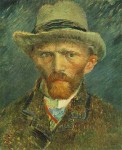
Vincent Van Gogh
Dutch, 1853-1890 (active France)
Lilacs, 1887
oil on canvas
Michael Armand Hammer and the Armand Hammer Foundation
Loan

Self-Portrait with Grey Felt Hat, 1887, Oil on cardboard, Rijksmuseum Amsterdam
“If you hear a voice within you say 'you cannot paint,' then by all means paint, and that voice will be silenced.“ - Vincent Van Gogh
COMMENTS
After arriving in Paris in 1886 Van Gogh was exposed for the first to the work of the Impressionists, and he discarded the somber palette of his earlier work in favor of the intense, unmixed color applied in quick dabs...
He made a series of color studies in painting, simply flowers, red poppies, blue cornflowers, and myosotis. He was seeking oppositions of blue and orange, red and green, yellow and violet, to harmonize brutal extremes. Trying to render intense color and not a gray harmony...
This spray of lilacs in brilliants pink and white belongs to a group of flower studies he made in autumn 1887.
- Armand Hammer Collection Exhibitions, Oklahoma City, 1971
…Van Gogh’s entire attention was on color. He painted a series of flower still lifes, setting himself the task much as he had with the series of peasants’ portraits. He produced over forty of them; they are not exactly among his greatest masterpieces, but they certainly prove his determination to master color. Theo describes the painting of these still lifes to their mother: “He is far more open-minded than he used to be, and very popular; for example, he has acquaintances who send him a fine bunch of flowers to paint every week. His main reason for painting flowers is that he wants to freshen his colors for later work.” The still lifes represented a transitional phase for van Gogh, at the end of which he was to be profoundly aware of the power of different tones. Afterwards he would indeed be able to create using only the palette–but not before.
These still lifes nevertheless represent his furthest progress to date. Van Gogh might have started improvising freely from the palette, adding color for its own sake, were it not for a figure of authority who confirmed him in his attachment to the subject: Adolphe Monticelli. Monticelli was a French painter of Italian extraction. His pictures of flowers were extremely pastose. And he was van Gogh’s first artistic discovery in Paris; Vincent was to value Monticelli till the end of his days. Theo and Vincent owned one or two of the Provençal artist’s impetuously painted canvases, works which made Vincent’s own brushwork look tame. But Monticelli, of course, was painting mimetic copies of flowers, even trying to use thick paint as a kind of relief to convey the tactile, physical dimension of his subject as well as the visual. “I have been trying to convey intensity of color,” van Gogh wrote to Lievens, referring to the flower still lifes. That was precisely it. The work he painted in 1886 was out to “convey”; it was still looking for (and in need of) the corrective reality would supply.
- Ingo F. Walther and Rainer Metzger, Vincent Van Gogh: The Complete Paintings, v. 1, Benedikt Taschen Verlag, 1993
SBMA CURATORIAL LABELS
After arriving in Paris in 1886, Van Gogh was exposed for the first time to the work of the Impressionists, and he discarded the somber palette of his earlier work in favor of intense, unmixed color applied in quick dabs. This spray of lilacs in brilliant pink and white belongs to a group of flower studies he made in the autumn 1887. He was less concerned with depicting the blossoms accurately than he was with wrestling with strong color and, as he told a fellow artist, “seeking... to harmonize brutal extremes.”
- Ridley-Tree Gallery 2016
